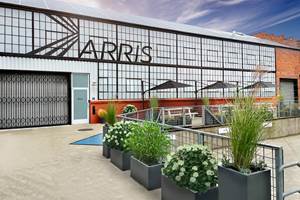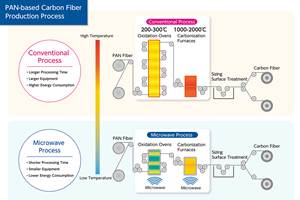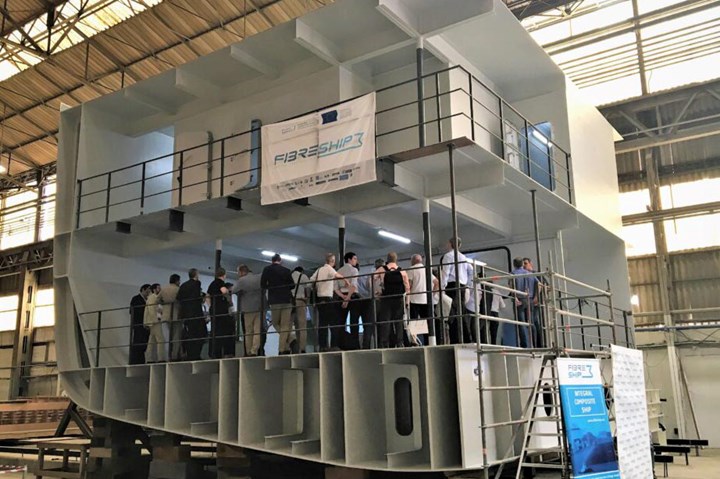
FIBRESHIP hull demonstrator
This 20-tonne section of an 85-m fishing research vessel measures 11 by 11 by 8.6 meter and reduces weight 70% vs. steel. Designed in composites by Technicas y Servicios de Ingeniría (TSI), this demonstrator is part of the FIBRESHIP project, fabricated to prove design and production capability for lightweight marine vessels more than 50 m in length. Source | FIBRESHIP, TSI
Glass and carbon fiber-reinforced polymer (GFRP and CFRP) composites have been used to build marine vessels for decades, including numerous 40- to 60-meter minehunters and even larger vessels, including the Swedish Navy’s 72-meter-long Visby Class Corvette and the 75-meter-long sailing yacht Mirabella V. The 141-meter motor yacht Swift 141 (renamed Yas) is a Dutch steel frigate rebuilt using GFRP/CFRP in below-deck soles and three-deck superstructure (see “From frigate to luxury gigayacht”), including a composite-to-steel deck joint.
And yet, composites are rarely used in shipbuilding. This is mainly due to the Safety Of Life At Sea (SOLAS) regulations issued by the International Maritime Organization (IMO, London, U.K.), which required that commercial ships be built in steel until until the MSC/Circ. 1002 was issued in 2002 permitting alternative designs.
“The regulation mandates a risk analysis to be performed, showing that the alternative design and construction is equivalent to steel,” explains Stéphane Paboeuf, head of the Composites Materials Section of the classification society Bureau Veritas (BV, Nantes, France). “This process is long, expensive and the final decision could still be negative.” Thus, although composites offer many advantages for shipbuilding, the challenges of fire safety and regulations have posed barriers to use.
Meanwhile, ship owners, operators and builders are seeking solutions for improved sustainability, including lighter weight to reduce fuel use, greenhouse gas emissions and vessel draft — the latter for shallow inland waterways. Composites’ inherent corrosion-resistance to curtail maintenance is also attractive.
In 2017, IMO issued MSC.1/Circ., a new set of guidelines for using FRP composites in commercial ships. As IMO’s evaluation of these guidelines in 2021 draws near, an amazing amount of activity is taking place. Two European consortia, FIBRESHIP and RAMSSES, supported by the 378-member European network for Lightweight Applications at Sea (E-LASS), are leading this wave of demonstration projects, which includes composite decks, rudders, hulls, modular cabins and superstructures, patch repairs to steel and composite-to-steel welded joints. Together, they aim to overcome the barriers for lightweight composite ship construction by not only demonstrating the fire and structural performance of large structures and whole vessels, but also by developing new routes for certification and production methods, new joining technologies and design tools. They are also sharing information via ongoing workshops, knowledge repositories and materials/design databases. A new market may be opening for marine composites, but what solutions will it require?
FIBRESHIP and RAMSSES
FIBRESHIP and RAMSSES were started in June 2017, funded by the European Union’s Horizon 2020 program. FIBRESHIP has 18 members and will run until May 2020, while RAMSSES has 36 members and ends in May 2021. Both include companies from across the supply chain spanning R&D centers, universities, materials and technology suppliers, parts fabricators, ship architecture and engineering firms, shipyards, ship owners and classification societies. The latter are responsible for developing specific rules for individual ship builds based on IMO’s general guidelines. They are authorized by flag states (each ship bears a country’s flag) to audit ship construction and ensure these rules are followed. “It is important that all of the stakeholders and end-users are involved,” says Alfonso Jurado, head of R&D at Tecnicas y Servicios de Ingeniería (TSI, Madrid, Spain) and FIBRESHIP project coordinator.
“FIBRESHIP’s main objective is to develop design and production capability for large marine vessels (more than 50 meters long) with less weight,” Jurado continues. “This is also the main motivation for my company.” TSI is designing the composite structure of an 85-meter length overall (LOA) fishing research vessel (FRV), which will serve as a demonstrator and, so far, achieves almost 70% reduction in structural weight versus the steel reference vessel. “This is amazing, offering the real possibility of help for the shipping sector,” he says. A 20-tonne section of this FRV, measuring 11 by 11 by 8.6 meters (see opening image), was constructed by partner iXblue shipyard in La Ciotat, France, and exhibited at FIBRESHIP’s second public workshop in June 2019 (see news posting with video of the demonstrator being fabricated).
Jurado explains that the FRV is the first of three general composite ship cases FIBRESHIP is developing. The next two are 260-meter LOA container ships and 204-meter ROPAX, the latter combining the cargo capacity of a roll-on/roll-off vessel with the passenger facilities of a ferry. “The FRV was chosen as demonstrator because it is smaller with a more conventional marine structure, and thus the most feasible to be built in the near future,” he says. “Ship owners have also shown a real interest in such a vessel.” Meanwhile, RAMSSES has 13 demonstrators in progress, 10 of which include composites, and is also pursuing an all-composite vessel.
Jurado notes that the companies participating in these projects see the potential for such novel designs and new lightweight products to provide a competitive advantage for their businesses as well as each country’s shipping industry. But progress won’t be secured by large demonstrators alone. “We must also have support from the regulatory authorities,” he adds. “A first step is to engage IMO and adapt the current SOLAS regulation to the new requirements and demands of the shipping industry. Without this, we cannot go forward because insurance companies will not underwrite the fiber-reinforced composite ships if they do not fulfill minimum requirements and the certification of safety, for example.”
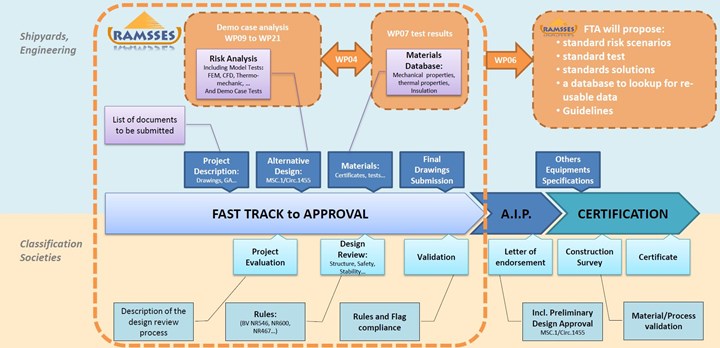
Proposed Fast Track to Approval (FTA) approach for certification of composites in commercial ships being developed within the RAMSSES project, as presented during the June 2019 E-LASS Seminar (Vigo, Spain). Source | RAMSSES and Stephane Paboeuf, Bureau Veritas
“FIBRESHIP is pursuing a long-term approach by developing new rules, while RAMSSES is developing a short-term approach by using existing rules and methods,” explains Paboeuf at BV, which is the only classification society partner in RAMSSES, and one of three in FIBRESHIP alongside Lloyd’s Register (London, U.K.) and RINA (Genoa, Italy). “In RAMSSES, we are developing a Fast Track to Approval (FTA) procedure based on reusing project data to standardize tests and provide guidance for design and approval.” This procedure is to be simple and easily readable by shipyards, naval architects and suppliers. Acceleration versus the current process will come through supports being developed in RAMSSES demonstration projects, including:
- a database of pre-approved solutions and materials test results to avoid repetitive testing,
- fire risk scenarios covering a range of similar applications to limit the number and extent of risk assessments, and
- analysis and modeling tools, including numerical or statistical models that may replace physical testing in the future.
“In FIBRESHIP, we are working with Lloyd’s Register and RINA to develop a set of prescriptive rules specifically for large vessels built with composites,” Paboeuf continues. “For structural performance, we are defining new safety coefficients for local and global loads.” RAMSSES and FIBRESHIP also propose to replace the current fire rating levels such as A60, B30 and B15 with a new convention REIxx, where R specifies fire resistance (load-bearing capacity in fire), E designates integrity (the prevention of smoke and flame spread) and I defines fire insulation. “The goal is to better align the structural fire ratings with the composite materials being used,” explains Paboeuf.
In addition, the two projects are also dealing with risk assessments due to flame spread, smoke production and fire risk in the space of origin, but also at ship global safety level. “For fire performance, we are developing a local equivalence approach, which deals with fire safety at a local level based on the fire ratings of the bulkheads and other structural divisions in each space of the vessel,” says Paboeuf. “The second approach, global equivalence, deals with fire at a vessel level, taking into account all systems (active and passive fire protection, detection, evacuation, etc.) that impact the fire safety of the vessel as a whole, not just each divided space.”
“Wider adoption of composites in shipbuilding will be step by step,” he says. “It will begin with small parts such as decks and superstructure, or equipment such as shaft lines and propellers, before progressing to construction of whole vessels, which at first will be mostly special purpose ships such as research and seismic testing vessels and high-speed patrol craft.”
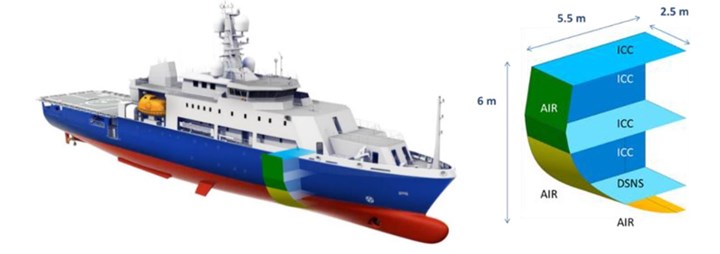
Fig. 1 RAMSSES 80-meter composite vessel
Damen Shipyard (DSNS) is developing an all-composite offshore patrol-type vessel in the RAMSSES project. Its 6-by-6-by-3-meter full-scale hull section demonstrator will be built in 2020 using resin infusion in collaboration with InfraCore Company (ICC) and Airborne International (AIR). Source | Damen Shipyard and RAMSSES
All-composite vessel demonstrators
In addition to the 85-meter FRV being demonstrated by FIBRESHIP, an 80-meter-long offshore patrol-type vessel is being developed within RAMSSES to be the first, all-composite SOLAS ship. Led by Damen Shipyard Group (Gorinchem, Netherlands), this work carries forward results from its Bluenose project started in 2014. Within RAMSSES work package 17, Damen is leading the demonstration of a 6-by-6-by-3-meter full-scale composite hull section of this vessel made using vacuum infusion, explains Matthias Krause, R&D engineer at the Center of Maritime Technologies (CMT, Hamburg, Germany) and co-coordinator of the RAMSSES project together with CETENA (Genoa, Italy). “Evonik has developed a novel resin for this demonstrator hull section and 6-meter-high tooling has been fabricated. Damen is also working with Airborne International (The Hague, Netherlands), an aircraft industry supplier that has also built large infused structures.” Evonik (Essen, Germany) has explained its role to improve the impact resistance and fatigue behavior of the glass fiber/vinyl ester infused hull.
Another partner in this demonstrator is InfraCore Co.(Rotterdam, Netherlands), which is developing new applications for the InfraCore technology used by sister company FiberCore Europe (Rotterdam) in more than 1,000 composite bridges and lock gates worldwide. “We originally joined Damen in this project to build a 12- to 14-ton helideck,” explains InfraCore operations manager Laurent Morel. “We are now working with them to build the decks, bulkheads and hull structure. We will use both horizontal and vertical infusion to produce the hull section in one shot. So far, we have infused to a height of 9.8 meters.” Once completed, this demonstrator will be tested for structural and fire performance, with results and lessons learned fed into the RAMSSES’s new FTA modules.
Lightweight decks
Composites have already been demonstrated in the first roll-on/roll-off car carrier to use a composite cargo deck, designed and built by Uljanik Group (Pula, Croatia) as part of RAMSSES work package 14 (see “Low weight on the high seas”), as well as a lightweight sundeck for a 110-meter-long river cruise ship (see “Composite deck reduces river ship draft”) and a composite tween deck for a 200-meter-long general cargo carrier. “A tween deck is a removable deck you can install to divide the cargo hold to facilitate different types of cargo,” explains Arnt Frode Brevik, manager at Compocean (Sandvika, Norway), a supplier of composite solutions that emerged from the oil and gas industry.
“We have been working with Oshima Shipbuilding (Nagasaki, Japan) and DNV GL for several years to develop a lightweight tween deck with the goal of cutting the weight by 50% versus steel,” says Brevik. This resulted in a 9-by-2-meter GRP prototype that was tested for impact and maximum loads and then exhibited at NOR-Shipping 2017.
Compocean has now extended this development to a new project with Oshima, DNV GL and ship owner Masterbulk Pte Ltd. (Singapore) to build a full-scale 27-by-12-meter prototype composite tween deck, which will be installed next year and tested until late 2021.
“Oshima was seeking to optimize items to reduce fuel and handling costs,” says Brevik. “Although there aren’t many tween decks per ship, it is an easy part to begin with when introducing new materials because it’s not part of the ship’s primary structure.” The design is based on a polyester resin-infused glass fiber plate with hat stiffeners underneath. “We use a mix of ±45-degree, 0-degree and 0-degree/90-degree layup for all parts but in different ratios. The deck structure also needs to integrate a lot of lashing points to secure the cargo.” The plate will be bonded to the hat stiffeners using a structural adhesive while bolting will be used in combination with the lashing system. A bolted steel end-bracket will join the composite to the steel ship structure. “We will also pursue a design with purely adhesive joints in the future,” adds Brevik.

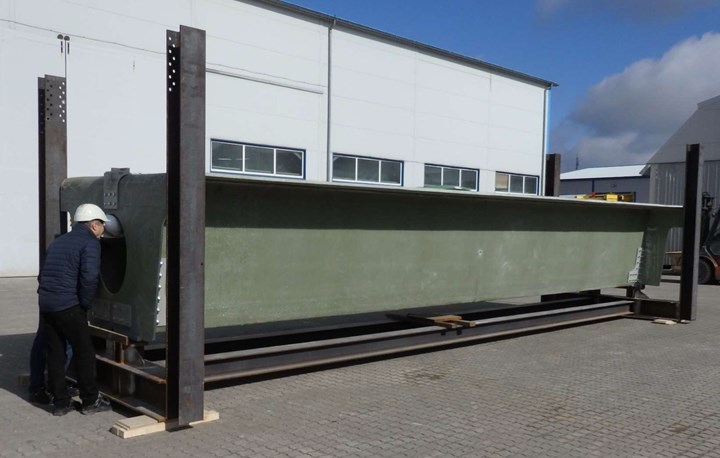
Fig. 2 Composite tween deck
Oshima Shipbuilding’s new 65k open-hatch general cargo carrier design will use Compocean’s prototype composite tween deck, which saves 50% weight vs. steel and will be comprised of multiple infused FRP hat stiffeners (inset) bonded to an FRP top plate with bolted connections from the composite to the steel ship structure. Source | Compocean and DNV GL
Having received final approval from DNV GL for the full-scale tween deck design, Compocean has produced the molds and started fabrication testing. “The full-scale composite deck will be built by a partner in Malaysia who will transport it via barge to the ship,” says Brevik. The next step is to aim for much more weight reduction, for example, composite hatches on top of cargo openings (flat plates on top of green “boxes” in ship rendering above). “There are seven big hatch covers on this type of carrier,” he notes. “To get these approved by DNV GL will pose some new challenges, but success with the tween deck will help.”
Lightweight superstructure, modular cabins
RAMSSES has six work packages focused on composite superstructures and components used above the main deck, most with demonstrators and test results to be presented in 2020. Work package 16, led by Naval Group (Paris, France), is demonstrating a lightweight composite superstructure module joined to a steel deck. The shore-based demonstrator represents a standard block for an offshore patrol-type vessel. “Shipbuilding in metallic materials is based on construction in blocks to decrease time and costs,” explains Jurado. “Building such blocks using composites presents issues with the need for large molds as well as joining techniques and joint safety requirements. Fibreship has studied this and developed some recommendations on joining of composite-based blocks, including the assembly sequence.” In RAMSSES, Naval Group has investigated three types of sandwich structures including GF/polyester/balsa core, FR epoxy/PET foam core and GF/polyester/3D fiber-reinforced foam core. It is also developing a structural health monitoring (SHM) system inside the joint and composite panels.
Work package 18, led by Chantiers de l’Atlantique (Saint Nazaire, France) is developing a modularized solution for passenger cabins. “These typically come without a floor because they are welded onto the ship’s steel decks,” says Krause. “The idea is to make them from composites, pre-outfitted with all auxiliary systems such as heating and air, electrical, etc. By including a composite floor, these could be inserted into a steel framework (like a drawer) versus welding onto a solid steel deck, thus saving a lot of weight.” Although the project is assessing composites to reduce production and assembly time for walls, ceilings and bathroom units, because replacing the steel deck would save an estimated 125 kilograms per square meter, composite floors are a main focus. Hutchinson (Paris, France) has proposed using its ZALTEX mineral fiber-reinforced composite foam, which resists temperatures from -190°C to 1,000°C.
Work package 13, led by cruise ship builder Meyer Werft (Papenburg, Germany), is also aimed at efficient processes for assembly, but targeting bulkheads. . The goal is build two demonstrators — one onshore, one offshore (sea trial) — where composite walls will be joined to steel frame structures and then subjected to 80 mechanical tests. Project partner InfraCore has performed analysis to define requirements for heat and noise insulation, eigenfrequency (vibration), deformation and maximum width and height for composite walls. “We have been asked to develop multifunctional inner and outer walls,” explains Morel at InfraCore. “To save time, cost and weight, we must integrate insulation and a good interior finish with the lightweight structural panel. There are up to 6800 square meters of these walls on every cruise ship. We have an opening to put these onboard a cruise ship in mid-2020, which could be the first SOLAS-approved composite walls on a cruise ship worldwide.”
In work package 10, Podcomp (Öjebyn, Sweden) is developing an alternative indoor/outdoor panel using bio-based composites that must be fire-retardant and competitively priced. Three sandwich concepts based on GF/polyfurfuryl alcohol (PFA) prepreg from Composites Evolution (Chesterfield, U.K.) and different core materials were examined. Only one concept passed cone calorimeter and other fire tests performed by RISE Research Institutes of Sweden (Borås). It is now being optimized for weight and cost.
After trying aluminum and friction-stir welding, Baltic Workboats (Nasva, Estonia) is now moving forward with composites to develop pre-fitted, stiffened panels for the deck house/superstructure of aluminum work boats (work package 15). Panel design, connection with other panels and to the rest of the deckhouse structure, structural analysis procedures and insulation solution will be demonstrated, as well as onboard installation techniques.
Another solution for lightweight superstructure is being developed by BaltiCo (Hohen Luckow, Germany), a ship equipment producer that has a new startup to build complete boats using robot-placed carbon fiber draped around truss structure. “You build the skeleton of the structure you want to produce, placing GFRP cross-structure or ribs about every half meter, and then a robot winds carbon fiber around it,” Krause explains. The goal is an ultra-lightweight modular system using a highly automated process. Demonstration will include production and assembly of two self-supporting hull and deck modules in a non-SOLAS lightweight solar-powered catamaran.
Welded FRP-steel joints
“We believe the future of shipbuilding is in combining FRP composites, steel and other materials into hybrid structures,” says Dr. Lars Molter, a 10-year veteran at CMT. “We looked at bonding, but there isn’t a standardized joint design you can use in all ships and there are no general rules on how to apply adhesive bonding in SOLAS vessels. Also, you must control the environment and bonding process.” He notes this is difficult amid the welding and cutting which typically dominates shipyard construction. “We asked DNV GL what they would approve for dissimilar-material joints,” says Molter. “They said primary structure would typically require a mechanical attachment; pure bonding would not be certified easily without redundant fasteners.”
Molter and CMT responded with the German-funded FAUSST (Fiber and Steel Standard joint) project, which developed a hybrid knitted fabric that transitions from 100% glass fibers to 100% steel fibers. The latter is welded to a steel connector (e.g., flat plate, rectangular profile, etc.), which can then be easily welded into a ship’s steel structure (Fig. 3). The glass fiber end is joined to the composite structure using resin infusion. “This joint design offers 100% NDT inspection because you can use UT (ultrasound) or X-ray on the weld,” says Molter. FAUSST performed mechanical, environmental and fatigue testing on this type of joint and also obtained approval in principle from the classifications societies, but there was still much work to do to transform the technology into a commercial product. Thus, Molter left CMT and founded HYCONNECT GmbH (Hamburg, Germany) in 2018.

Fig. 3 HYCONNECT welded steel-FRP joint
FAUSST hybrid steel-glass fiber fabric (top left) is press welded to a steel plate or other connector (top right) and can then be integrated into a composite structure via resin infusion (bottom left). Such hybrid composite structures are then easily welded into steel ship framing (bottom right).
Source | HYCONNECT
“We have met with shipyards, DNV GL and BV and are developing a product which can be certified,” says Molter. “You simply order your composite parts with this joint system and then you can weld them into your ship. That is our vision. We design the composite-to-steel joint and then deliver a product which has fabric welded to a steel connector (plate, profile, etc.).”
He explains that the joint design and fabric will be certified in a stepwise system: “By applying more layers of FAUSST fabric, there is a linear increase in load-carrying capability.” For example, the base product could be four layers of FAUSST with a 1-meter flat bar welded to it, rated for a certain tensile and bending load. Then there would be some products available to the left (e.g., two-three layers total for a lower load rating) and right (e.g., six layers total for a higher load rating). “We are still finalizing these details, but the goal is a standardized and easy-to-use system,” notes Molter.
HYCONNECT has adapted the fabric technology to handle the difference in stiffness and coefficient of thermal expansion (CTE) between steel and composites; the use of knitted fibers for mechanical interlocking with unidirectional fibers for carrying load through the joint; and the technique required for high-quality press welding of the steel fibers to the steel connector (see "Connecting composites to steel”). “This solution is based on continuous testing,” says Molter. “Because FAUSST consists of standardized ready-made sub-products, it can be supplied quickly, within days.” Prototypes are currently being produced for selected customers, and HYCONNECT will begin full production in 2020.
Composite rudders
Ship rudders are also being developed as FRP-steel hybrids. As part of RAMSSES work package 12, Becker Marine Systems (BMS, Hamburg, Germany) is demonstrating a lightweight composite flap for a steel rudder designed for large container ships. Such rudders typically weigh more than 200 tons, says Jörg Mehldau, head of R&D at BMS. “By adding a hinged aft flap, you can significantly reduce the rudder area.” BMS pioneered this flap rudder, which dramatically reduces ship turning radius and improves course-keeping and maneuverability, enabling berthing without tugboat assistance. A composite flap not only reduces weight but also enables more functional shapes as well as more hydrodynamically- and load-optimized designs.

Fig. 4 Composite rudder flap
Becker Marine Systems is working with InfraCore to develop a lightweight, resin-infused rudder flap for the largest container ships. Measuring 11.8 meters long and 0.9 meter wide with a 2.9 meter chord, the full-scale flap must withstand 100 tons/m2 of load. A 2-meter high demo will be tested 2Q 2020. Source| Becker Marine Systems
“The composite flap we are developing was inspired by the aviation industry,” notes Mehldau. For RAMSSES, the full-scale test case is aimed at one of the largest container ships (≈400 meters long), a flap measuring 11.8 longmeters and 0.9 meters wide with a chord of 2.9 meters (see Fig. 4). “We calculated the forces on this rudder and flap using formulas based on DNV GL rules for this ship’s type, weight and maximum speed,” says Mehldau. BMS then conducted preliminary design and engineering analysis, as well as trade studies for manufacturability and cost. “We first favored filament winding but it was too expensive,” he notes. “For each new ship hull, the rudder is a single design.” Thus, resin infusion was chosen, as was an alternative design from InfraCore. “It was the best for production flexibility, cost and structural performance combined,” Mehldau explains.
“To me, this was a natural fit for InfraCore because the composite lock gates we have built are very similar,” says Morel. He notes container ship rudders must withstand loads of roughly 100 tons per square meter with a surface area of 150 square meters. This matches well with InfraCore’s infusion-based technology used in bridge decks spanning up to 142 meters. Instead of bonding a high-density structural core to faceskins, InfraCore uses a low-density foam core only as a permanent formwork for multiple Z-shaped, two-flanged web structures. These are overlapped, faced with multiaxial fabrics and co-infused to form a robust construction. InfraCore will build a 1:6 scale demonstrator, using glass fiber and polyester resin materials already certified by DNV GL to keep costs low.
Morel notes that the reduced-weight InfraCore composite flap is cost-competitive, “because steel ship rudders are quite complicated to manufacture.” Mehldau agrees, “together with less maintenance and operational cost advantages, we see a successful business case.” The 2-meter -high demonstrator will be finished by 2Q 2020, followed by testing.
“We will test this using a lab test bench and air cushions, which can apply up to 8 bar of pressure equal to at least 80 Mpa of load,” says Mehldau. “We will measure strains and deflections to verify our simulations and perform a break load test.” A lab-scale demonstrator will also be tested via sea trials on a research ship in the Elbe River by CETENA (Genoa, Italy) which serves as project coordinator for RAMSSES along with CMT.
Forward momentum
“The outlook for composites in ships is good because many of the marine sector stakeholders have shown interest in FIBRESHIP, RAMSSES and other projects,” says Jurado. “The largest challenges are the need for new regulations, fire safety aspects, bonding techniques and reduction of shipbuilding costs.” For the latter, he cites automated manufacturing in shipyards as a key issue as well as mold construction and composite materials sourcing and storage. “Composites are already growing in ships,” says Krause at CMT, “but we started this work 20 years ago, so it is a slow process. However, we now have this critical mass and the industry is more connected via E-LASS.”
Jörg Bünker, head of R&D, application service for SAERTEX LEO FR products at SAERTEX (Saerbeck, Germany), agrees: “The drivers to reduce weight are strengthening. Within the next five to seven years, more composite materials will be sold into ships. This is the right time for more projects because IMO needs to see this interest and effort from the industry. Suppliers must show new solutions and shipyards must show where composites can be used, but no one can do it alone.”
Related Content
Plant tour: Arris Composites, Berkeley, Calif., U.S.
The creator of Additive Molding is leveraging automation and thermoplastics to provide high-volume, high-quality, sustainable composites manufacturing services.
Read MoreJEC World 2023 highlights: Recyclable resins, renewable energy solutions, award-winning automotive
CW technical editor Hannah Mason recaps some of the technology on display at JEC World, including natural, bio-based or recyclable materials solutions, innovative automotive and renewable energy components and more.
Read MoreMicrowave heating for more sustainable carbon fiber
Skeptics say it won’t work — Osaka-based Microwave Chemical Co. says it already has — and continues to advance its simulation-based technology to slash energy use and emissions in manufacturing.
Read MoreNatural fiber composites: Growing to fit sustainability needs
Led by global and industry-wide sustainability goals, commercial interest in flax and hemp fiber-reinforced composites grows into higher-performance, higher-volume applications.
Read MoreRead Next
All-recycled, needle-punched nonwoven CFRP slashes carbon footprint of Formula 2 seat
Dallara and Tenowo collaborate to produce a race-ready Formula 2 seat using recycled carbon fiber, reducing CO2 emissions by 97.5% compared to virgin materials.
Read More“Structured air” TPS safeguards composite structures
Powered by an 85% air/15% pure polyimide aerogel, Blueshift’s novel material system protects structures during transient thermal events from -200°C to beyond 2400°C for rockets, battery boxes and more.
Read MorePlant tour: Daher Shap’in TechCenter and composites production plant, Saint-Aignan-de-Grandlieu, France
Co-located R&D and production advance OOA thermosets, thermoplastics, welding, recycling and digital technologies for faster processing and certification of lighter, more sustainable composites.
Read More
















